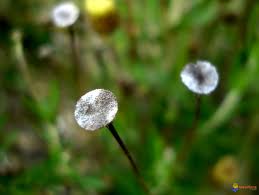Common Brighteyes – Picridie vulgaire
La coustelline, the Provençal name for this little plant, is the ‘queen’ of the wild salad greens.  It is a Mediterranean plant that seems to grow on any type of soil whether it is sandy or rocky, near the sea or the garrigue, the only requirement is that the soil should be free draining. On first impression it looks a bit like a dandelion, but it has two characteristics that set it apart: firstly, its leaves have a bluish sheen; secondly, after the flower has withered away, what is left is a silvery shiny disk that dips in the middle on a long stalk. As mentioned before, the leaves resemble dandelion leaves; they can be entire or pinnately lobed with a pronounced central vein. On close inspection, although the leaves can be smooth, they often have small fleshy projections, which are in fact air cells.
It is a Mediterranean plant that seems to grow on any type of soil whether it is sandy or rocky, near the sea or the garrigue, the only requirement is that the soil should be free draining. On first impression it looks a bit like a dandelion, but it has two characteristics that set it apart: firstly, its leaves have a bluish sheen; secondly, after the flower has withered away, what is left is a silvery shiny disk that dips in the middle on a long stalk. As mentioned before, the leaves resemble dandelion leaves; they can be entire or pinnately lobed with a pronounced central vein. On close inspection, although the leaves can be smooth, they often have small fleshy projections, which are in fact air cells.  From the same root, several rosettes grow, overlapping each other, which gives the plant a bit of an untidy look. Care has to be taken when harvesting that only the top rosette is removed. Within 3 weeks another rosette will have grown in its place, ready for picking again. The flower stalk is between 30-45 cm long. A few small leaves clasp the flower stalk. The flowers are like dandelions but smaller, with never more than two flowers on each stalk.
From the same root, several rosettes grow, overlapping each other, which gives the plant a bit of an untidy look. Care has to be taken when harvesting that only the top rosette is removed. Within 3 weeks another rosette will have grown in its place, ready for picking again. The flower stalk is between 30-45 cm long. A few small leaves clasp the flower stalk. The flowers are like dandelions but smaller, with never more than two flowers on each stalk.
In a recent European study, 127 wild and semi-wild Mediterranean plants were analysed to determine whether they were a factor in the better aging of the rural Mediterranean population, who, as part of their diet, eat wild plants. Reichardia picroïdes was one of the plants examined. It scored very highly with regard to anti-oxident activity.
who, as part of their diet, eat wild plants. Reichardia picroïdes was one of the plants examined. It scored very highly with regard to anti-oxident activity.
Reichardia picroïdes makes a very tasty salad leaf, slightly crunchy, sweet and bitter at the same time. A simple dish in winter would be to combine the chopped up leaves with mashed potatoes and bits of bacon. In Holland this is done, not with Reichardia leaves but with ‘Scarolle’, both leaves being slightly bitter.
Bibliography: Les cueillettes sauvages – Rustica; Plants de Mediterranée – Wolfgang Lippert/Dieter Podlech; http://www.nutritional-neuroscience.com; Local European Medical & Food Plants, how they contribute to improved health – Michael Heinrich, Centre for Pharmacognosy, The School of Pharmacy, University of London
